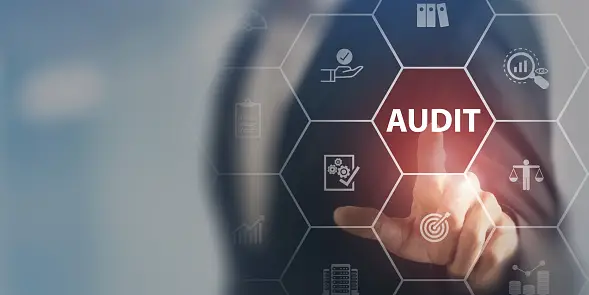4.0. Application of data analytics in specialised areas
4.2. Auditing
Carry out 3-way order matching

Application of Data Analytics in Auditing
What is a 3-way order matching ?
A 3-way order matching is a common business and accounting practice used to ensure accuracy and control in the purchase-to-pay (P2P) process. It involves comparing three essential documents related to a purchase transaction: purchase orders (POs), receiving reports (also known as goods receipts), and supplier invoices. The primary purpose of this matching process is to verify that a company is being charged correctly for the goods or services it has received.
Related content:
4.2. Auditing
4.2.1. Analysis of trends in key financial statements components 4.2.2. Carry out 3-way order matching 4.2.3. Fraud detection 4.2.4. Test controls (specifically segregation of duties) by identifying combinations of users involved in processing transactions 4.2.5. Carry out audit sampling from large data set 4.2.6. Model review and validation issues
Application of Data Analytics in Auditing: 3-Way Order Matching
In the world of auditing, the application of data analytics has introduced transformative ways to assess the accuracy, integrity, and compliance of financial transactions. One such powerful application is the use of data analytics for 3-way order matching, a process that enhances audit efficiency, reduces errors, and provides auditors with a robust tool for uncovering discrepancies, fraud, or inefficiencies in the procurement and accounts payable functions of an organization.
The 3-Way Order Matching Process:
The 3-way order matching process is a core component of the purchase-to-pay (P2P) cycle. It involves the meticulous comparison of three critical documents associated with a purchase transaction: Purchase Orders (POs), Receiving Reports (or Goods Receipts), and Supplier Invoices. This process serves to validate that a company is billed accurately for the goods or services it has received. Here's a detailed breakdown of each step:
- Purchase Order (PO):
- The PO is the inception of the procurement process. It's a formal document generated when a company decides to procure goods or services from a supplier.
- The PO contains comprehensive details about the purchase, including item descriptions, quantities, agreed-upon prices, delivery dates, and supplier information.
- Data analytics tools can be used to extract and analyze information from POs, ensuring they align with the purchasing guidelines and budgets.
- Receiving Report (Goods Receipt):
- After the supplier delivers the ordered goods or completes the services, the receiving department within the buying company generates a receiving report or goods receipt.
- This document is crucial in acknowledging the receipt of items and includes critical data points such as the actual quantity received, the condition of the goods, and any noted discrepancies or damages.
- Data analytics can be employed to cross-reference the data in the receiving report with the details outlined in the PO.
- Supplier Invoice:
- Once the goods or services have been received, the supplier sends an invoice to the purchasing company, requesting payment for the delivered items.
- The invoice should ideally match the terms and conditions specified in the PO, including the agreed-upon prices, quantities, and any other relevant particulars.
- Data analytics can facilitate the automatic comparison of the supplier's invoice with the information in the PO to identify any inconsistencies or discrepancies.
The Role of Data Analytics in 3-Way Order Matching:
Data analytics plays a pivotal role in automating and expediting the 3-way order matching process. It can swiftly and accurately extract data from these documents, making it easier for auditors to perform detailed comparisons.
Machine learning algorithms and data matching techniques enable auditors to identify discrepancies, even in large datasets, by flagging inconsistencies such as shortages, overages, pricing errors, or unapproved charges.
Advanced analytics can also facilitate anomaly detection by highlighting unusual patterns or outliers, which could indicate fraudulent activities or procedural breakdowns.
Benefits of Data Analytics in 3-Way Order Matching:
- Enhanced Accuracy: Data analytics tools significantly reduce the risk of human errors and oversight in the matching process.
- Improved Efficiency: Auditors can analyze a larger volume of transactions in less time, allowing for more comprehensive coverage.
- Fraud Detection: Data analytics helps auditors uncover irregularities that may indicate fraudulent activities within the procurement cycle.
- Cost Savings: By identifying discrepancies, data analytics contributes to cost control by preventing overpayments and ensuring accurate billing.
The application of data analytics in auditing, particularly in the context of 3-way order matching, represents a significant leap forward in audit efficiency and accuracy. By automating the comparison of key documents within the procurement process, auditors are empowered to identify discrepancies, mitigate risks, and contribute to improved financial controls and compliance within organizations. This not only enhances the audit process but also contributes to better financial management and decision-making.
Auditing & Assurance
Table of contents
Syllabus
-
1.0
Introduction to Excel
- Microsoft excel key features
- Spreadsheet Interface
- Excel Formulas and Functions
- Data Analysis Tools
- keyboard shortcuts in Excel
- Conducting data analysis using data tables, pivot tables and other common functions
- Improving Financial Models with Advanced Formulas and Functions
-
2.0
Introduction to data analytics
-
3.0
Core application of data analytics
- Financial Accounting And Reporting
- Statement of Profit or Loss
- Statement of Financial Position
- Statement of Cash Flows
- Common Size Financial Statement
- Cross-Sectional Analysis
- Trend Analysis
- Analyse financial statements using ratios
- Graphs and Chats
- Prepare forecast financial statements under specified assumptions
- Carry out sensitivity analysis and scenario analysis on the forecast financial statements
- Data visualization and dash boards for reporting
- Financial Management
- Time value of money analysis for different types of cash flows
- Loan amortization schedules
- Project evaluation techniques using net present value - (NPV), internal rate of return (IRR)
- Carry out sensitivity analysis and scenario analysis in project evaluation
- Data visualisation and dashboards in financial management projects
-
4.0
Application of data analytics in specialised areas
- Management accounting
- Estimate cost of products (goods and services) using high-low and regression analysis method
- Estimate price, revenue and profit margins
- Carry out break-even analysis
- Budget preparation and analysis (including variances)
- Carry out sensitivity analysis and scenario analysis and prepare flexible budgets
- Auditing
- Analysis of trends in key financial statements components
- Carry out 3-way order matching
- Fraud detection
- Test controls (specifically segregation of duties) by identifying combinations of users involved in processing transactions
- Carry out audit sampling from large data set
- Model review and validation issues
- Taxation and public financial management
- Compute tax payable for individuals and companies
- Prepare wear and tear deduction schedules
- Analyse public sector financial statements using analytical tools
- Budget preparation and analysis (including variances)
- Analysis of both public debt and revenue in both county and national government
- Data visualisation and reporting in the public sector
-
5.0
Emerging issues in data analytics


